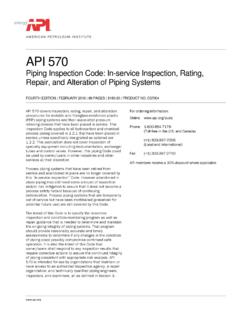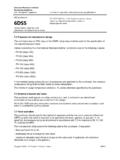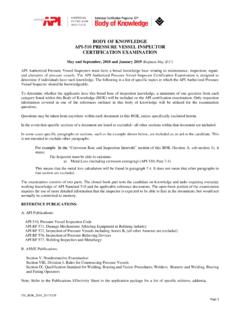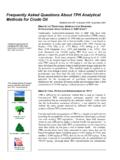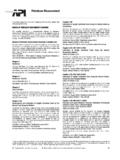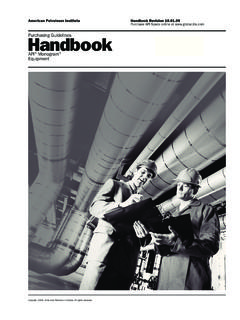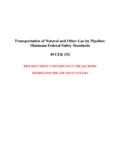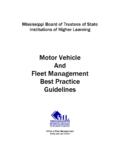Transcription of WHICH OIL IS RIGHT FOR YOU? - API
1 WHICH OILIS RIGHTFOR YOU? Certification Mark, also known as the Starburst An oil displaying this mark meets the current engine protection standard and fuel economy requirements of the International Lubricant Specification Advisory Committee (ILSAC), a joint effort of and Japanese automobile manufacturers. Automobile manufacturers recommend oils that carry the API Certification Mark. See the ILSAC STANDARD FOR PASSENGERCAR ENGINE OILS chart on the next page for descriptions of current andobsolete ILSAC Service Symbol, alsoknown as the Donut 1.
2 Performance LevelMotor oils designed for cars, vans, and light trucks with gasoline enginesfall under API s S (Service) categories. Motor oils designed for heavy-duty trucks and vehicles with diesel engines fall under API s C (Commercial) categories. Please see the Gasoline Engines and DieselEnginescharts on the next pages for descriptions of current and obsolete API service categories. 2. Viscosity GradeThe measure of an oil s ability to flow at certain requirements may vary. Follow your vehicle manufacturer s recommendations on SAE oil resource Conserving and Energy ConservingThese designations apply to oils intended for gasoline-engine cars, vans,and light trucks.
3 Widespread use of resource Conserving or EnergyConserving oils may result in an overall savings of fuel in the vehiclefleet as a whole. 4. Multiple Performance LevelsOils designed for diesel engine service might also meet gasoline engineservice. For these oils the designation is C category first followed bythe S category. C category oils have been formulated primarily fordiesel engines and may not provide all of the performance requirementsconsistent with vehicle manufacturers recommendations for gasoline-fueled engines.
4 5. The API Service Symbol with CI-4 PlusThe CI-4 PLUS designation identifies oils formulated to provide a higherlevel of protection against soot-related viscosity increase and viscosityloss due to shear in diesel engines. When originally introduced, CI-4 PLUS identified CI-4 oils meeting a higher level of performance. CJ-4 oilsinclude all CI-4 PLUS performance requirements. CI-4 PLUS appears inthe lower portion of the API Service Symbol Donut. GET MOREFROM YOURMOTOR your vehiclemanufacturer s oil changerecommendations.
5 This includes using recommendedSAE oil viscosity and ILSAC or API performance you find it necessaryto mix brands of oil, usesame viscosity grade and API service category to maintain dispose of used oil. Learn more about recycling used oil at Go to for used oil collection center for API- licensed oil whenever youhave your for API CertificationMarks every timeyou buy motor more information visit about chemical additives in motor oil s Cer tificationMark and ServiceSymbolidentify quality motor oils for gasoline- and diesel-powered vehicles.
6 Oils displaying these marks meetperformance requirements set by and international vehicleand engine manufacturers and the lubricant industry. More than 500 companies worldwide participate in this voluntary program, WHICH is backed by a marketplace sampling and testing program. ILSAC STANDARD FOR PASSENGER CAR ENGINE OILSNameStatusServiceGF-5 CurrentIntroduced in October 2010, designed to provide improved high temperature deposit protection for pistons and turbochargers, more stringent sludge control, improved fuel economy, enhanced emission control system compatibility, seal compatibility.
7 And protection of engines operating on ethanol-containing fuels up to GF-5 where GF-4 is GF-5 where GF-3 is GF-5 where GF-2 is GF-5 where GF-1 is ENGINES(Follow your vehicle manufacturer s recommendations on oil performance levels)Category StatusServiceSNCurrentIntroduced in October 2010, designed to provide improved high temperature deposit protection for pistons, more stringent sludge control, and seal compatibility. API SN with resource Conserving matches ILSAC GF-5 by combining API SN performance with improved fuel economy, turbocharger protection, emission control system compatibility, and protection of engines operating on ethanol-containing fuels up to 2010 and older automotive 2004 and older automotive 2001 and older automotive :For 1996 and older automotive :Not suitable for use in most gasoline-powered automotive engines built after 1993.
8 May not provide adequate protection against build-up of engine sludge, oxidation, or :Not suitable for use in most gasoline-powered automotive engines built after 1988. May not provide adequate protection against build-up of engine :Not suitable for use in most gasoline-powered automotive engines built after :Not suitable for use in most gasoline-powered automotive engines built after 1971. Use in more modern engines may cause unsatisfactory performance or equipment :Not suitable for use in most gasoline-powered automotive engines built after 1967.
9 Use in more modern engines may cause unsatisfactory performance or equipment :Not suitable for use in most gasoline-powered automotive engines built after 1951. Use in more modern engines may cause unsatisfactory performance or equipment :Contains no additives. Not suitable for use in most gasoline-powered automotive engines built after 1930. Use in modern engines may cause unsatisfactory performance or equipment current and previous ILSAC standards and API Service Categories are listed here. Vehicle owners should refer to their owner s manuals beforeconsulting these charts.
10 Oils may have more than one performance automotive gasoline engines, the latest ILSAC standard or API Service Category includes the performance properties of each earlier category andcan be used to service older engines where earlier category oils were Oil Licensing and Certification System| 1220 L Street, NW| Washington, DC 20005-4070| USA| Telephone: 202-682-8516| Email: 2013 American Petroleum Institute, all rights reserved. API, the API logo, the Motor Oil Matters Seal, the API Service Symbol (Donut), the API Service Symbol with CI-4 PLUS logo, the API Certification Mark (Starburst), and the Mom Knows Best and Motor Oil Matters phrases are either trademarks or registered trademarks of API in the United States and/or other countries.
